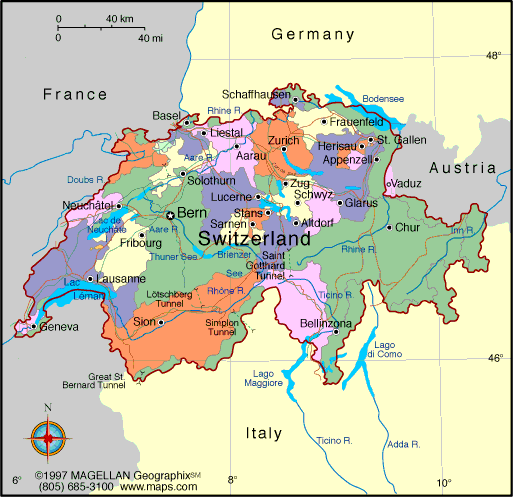SWITZERLAND

Geography: Switzerland, in central Europe, is the land of the Alps. Its tallest peak is the Dufourspitze at 15,203 ft (4,634 m) on the Swiss side of the Italian border, one of 10 summits of the Monte Rosa massif. The tallest peak in all of the Alps, Mont Blanc (15,771 ft; 4,807 m), is actually in France. Most of Switzerland is composed of a mountainous plateau bordered by the great bulk of the Alps on the south and by the Jura Mountains on the northwest. The country's largest lakes—Geneva, Constance (Bodensee), and Maggiore—straddle the French, German-Austrian, and Italian borders, respectively. The Rhine, navigable from Basel to the North Sea, is the principal inland waterway.
Government: Federal republic.
History: Called Helvetia in ancient times, Switzerland in 1291 was a league of cantons in the Holy Roman Empire. Fashioned around the nucleus of three German forest districts of Schwyz, Uri, and Unterwalden, the Swiss Confederation slowly added new cantons. In 1648 the Treaty of Westphalia gave Switzerland its independence from the Holy Roman Empire.
French revolutionary troops occupied the country in 1798 and named it the Helvetic Republic, but Napoléon in 1803 restored its federal government. By 1815, the French- and Italian-speaking peoples of Switzerland had been granted political equality.
In 1815, the Congress of Vienna guaranteed the neutrality and recognized the independence of Switzerland. In the revolutionary period of 1847, the Catholic cantons seceded and organized a separate union called the Sonderbund , but they were defeated and rejoined the federation.
Government: Federal republic.
History: Called Helvetia in ancient times, Switzerland in 1291 was a league of cantons in the Holy Roman Empire. Fashioned around the nucleus of three German forest districts of Schwyz, Uri, and Unterwalden, the Swiss Confederation slowly added new cantons. In 1648 the Treaty of Westphalia gave Switzerland its independence from the Holy Roman Empire.
French revolutionary troops occupied the country in 1798 and named it the Helvetic Republic, but Napoléon in 1803 restored its federal government. By 1815, the French- and Italian-speaking peoples of Switzerland had been granted political equality.
In 1815, the Congress of Vienna guaranteed the neutrality and recognized the independence of Switzerland. In the revolutionary period of 1847, the Catholic cantons seceded and organized a separate union called the Sonderbund , but they were defeated and rejoined the federation.

Map of
Switzerland
President: Simonetta Sommaruga (2015)
Land area: 15,355 sq mi (39,769 sq km);
total area: 15,942 sq mi (41,290 sq km)
Population (2014 est.): 8,061,516 (growth
rate: 0.78%); birth rate: 10.48/1000; infant mortality rate: 3.73/1000;
life expectancy: 82.39
Capital (2011 est.):
Bern, 353,000
Largest cities: Zurich, 1.194 million
Monetary unit: Swiss
franc
National
name: Schweiz/Suisse/Svizzera/Svizra
Languages:
German (official) 64.9%, French (official) 22.6%,
Italian (official) 8.3%, Serbo-Croatian 2.5%, Albanian 2.6%, Portuguese
3.4%, Spanish 2.2%, English 4.6%, Romansch (official) 0.5%, other 5.1%
(2012 est.)
Ethnicity/race:
German 65%, French 18%, Italian 10%, Romansch
1%, other 6%
Religions:
Roman Catholic 38.2%, Protestant 26.9%, Muslim 4.9%, other Christian 5.7%, other 1.6%, none 21.4%, unspecified 1.3% (2012 est.)
Literacy
rate: 99% (2003 est.)
Economic
summary: GDP/PPP (2013 est.): $371.2 billion; per capita
$54,800. Real growth rate: 2%. Inflation: -0.4%.
Unemployment: 3.2%. Arable land: 9.8%.
Agriculture: grains, fruits, vegetables; meat, eggs. Labor
force: 4.976 million (2013); services 73.2%, industry 23.4%, agriculture 3.4%
(2010). Industries: machinery, chemicals, watches, textiles,
precision instruments, tourism, banking, insurance. Natural resources: hydropower potential,
timber, salt. Exports: $229.2 billion (2013 est.):
machinery, chemicals, metals, watches, agricultural products.
Imports: $200.5 billion (2013 est.): machinery, chemicals,
vehicles, metals; agricultural products, textiles. Major trading
partners: Germany, U.S., France, Italy, UK, China,
Austria (2013).
Communications:
Telephones: main lines in use: 4.382 million (2012); mobile
cellular: 10.46 million (2012). Broadcast media:
the publicly-owned radio and TV broadcaster, Swiss Broadcasting
Corporation (SRG/SSR), operates 7 national TV networks, 3 broadcasting
in German, 2 in Italian, and 2 in French; private commercial TV stations
broadcast regionally and locally; TV broadcasts from stations in
Germany, Italy, and France are widely available via multi-channel cable
and satellite TV services; SRG/SSR operates 18 radio stations that,
along with private broadcasters, provide national to local coverage
(2009). Internet Service Providers (ISPs): 5.301 million (2012). Internet users: 6.152 million
(2009).
Transportation: Railways:
total: 4,876 km (2008). Highways: total: 71,464 km; paved:
71,464 km (including 1,415 km of expressways); unpaved: 0 km (2011).
Waterways: 1,292 km (2010) Ports and harbors: Basel.
Airports: 63 (2013).
International
disputes: none.
-------------------- o --------------------
No comments:
Post a Comment